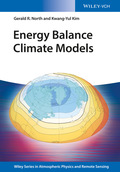Energy Balance Climate Models
Wiley Series in Atmospheric Physics and Remote Sensing

1. Edition September 2017
XVI, 369 Pages, Hardcover
100 Pictures
Monograph
Short Description
This book covers all major aspects of Energy Balance Models, starting from the most simple zero-dimensional models and then proceeding to horizontally and vertically resolved models.
Written by renowned experts in the field, this first book to focus exclusively on energy balance climate models provides a concise overview of the topic. It covers all major aspects, from the simplest zero-dimensional models, proceeding to horizontally and vertically resolved models.
The text begins with global average models, which are explored in terms of their elementary forms yielding the global average temperature, right up to the incorporation of feedback mechanisms and some analytical properties of interest. The effect of stochastic forcing is then used to introduce natural variability in the models before turning to the concept of stability theory. Other one dimensional or zonally averaged models are subsequently presented, along with various applications, including chapters on paleoclimatology, the inception of continental glaciations, detection of signals in the climate system, and optimal estimation of large scale quantities from point scale data. Throughout the book, the authors work on two mathematical levels: qualitative physical expositions of the subject material plus optional mathematical sections that include derivations and treatments of the equations along with some proofs of stability theorems.
A must-have introduction for policy makers, environmental agencies, and NGOs, as well as climatologists, molecular physicists, and meteorologists.
CLIMATE AND CLIMATE MODELS
Defining Climate
Elementary Climate System Anatomy
Radiation and Climate
Hiercharchy of Climate Models
Greenhouse Effect and Modern Climate Change
Reading this Book
Cautionary Note and Disclaimer
Notes on Further Reading
GLOBAL AVERAGE MODELS
Temperature and Heat Balance
Time Dependence
Spectral Analysis
Nonlinear Global Model
Summary
RADIATION AND VERTICAL STRUCTURE
Radiance and Radiation Flux Density
Equation of Transfer
Gray Atmosphere
Plane Parallel Atmosphere
Radiative Equilibrium
Simplified Model for Water Vapor Absorber
Cooling Rates
Solutions for Uniform-Slab Absorbers
Vertical Heat Conduction
Convective Adjustment Models
Lessons from Simple Radiation Models
Criticism of the Gray Spectrum
Aerosol Particles
GREENHOUSE EFFECT AND CLIMATE FEEDBACKS
Greenhouse Effect without Feedbacks
Infrared Spectra of Outgoing Radiation
Summary of Assumptions and Simplifications
Log Dependence of the CO2 Forcing
Runaway Greenhouse Effect
Climate Feedbacks and Climate Sensitivity
Water Vapor Feedback
Ice Feedback for the Global Model
Probability Density of Climate Sensitivity
Middle Atmosphere Temperature Profile
Conclusion
Notes for Further Reading
LATITUDE DEPENDENCE
Spherical Coordinates
Incoming Solar Radiation
Extreme Heat Transport Cases
Heat Transport Across Latitude Circles
Diffusive Heat Transport
Deriving the Legendre Polynomials
Solution of the Linear Model with Constant Coefficients
The Two-Mode Approximation
Poleward Transport of Heat
Budyko's Transport Model
Ring Heat Source
Advanced Topic: Formal Solution for More General Transports
Ice Feedback in the 2-Mode Model
Polar Amplification through Icecap Feedback
Chapter Summary
TIME DEPENDENCE IN THE 1-D MODEL
Differential Equation for Time Dependence
Decay of Anomalies
Seasonal Cycle on a Homogeneous Planet
Spread of Diffused Heat
Random Winds and Diffusion
Numerical Methods
Spectral Methods
Chapter Summary
Appendix: Solar Heating Distribution
NONLINEAR PHENOMENA IN EBMS
Formulation of the Nonlinear Feedback Model
Stürm-Liouville Modes
Linear Stability Analysis
Finite Perturbation Analysis and Potential Function
Small Ice Cap Instability
Snow Caps and the Seasonal Cycle
Mengel's Land Cap Model
Chapter Summary
TWO HORIZONTAL DIMENSIONS AND SEASONALITY
Beach Ball Seasonal Cycle
Eigenfunctions in the Bounded Plane
Eigenfunctions on the Sphere
Spherical Harmonics
Solutions of the EBM with Constant Coefficients
Introducing Geography
Global Sinusoidal Forcing
Two Dimensional Linear Seasonal Model
Present Seasonal Cycle Comparison
Chapter Summary
PERTURBATION BY NOISE
Time-Independent Case for Uniform Planet
Time-Dependent Noise Forcing for Uniform Planet
Green's Function on the Sphere: f=0
Apportionment of Variance at a Point
Stochastic Model with Realistic Geography
Thermal Decay Modes with Geography
TIME-DEPENDENT RESPONSE AND THE OCEAN
Single-Slab Ocean
Penetration of a Periodic Heating at the Surface
Two-Slab Ocean
Box-Diffusion Ocean Model
Steady State of Upwelling-Diffusion Ocean
Upwelling Diffusion with (and without) Geography
Influence of Initial Conditions
Response to Periodic Forcing with Upwelling Diffusion Ocean
Summary and Conclusions
APPLICATIONS OF EBSM: OPTIMAL ESTIMATION
Introduction
Independet Estimators
Estimating Global Average Temperature
Deterministic Signals in the Climate System
APPLICATIONS OF EBMS: PALEOCLIMATE
Paleoclimatology
Precambrian Earth
Glaciations in the Permian
Glacial Inception on Antarctica
Clacial Inception on Greenland
Pleistocene Glaciations and Milankovic
Kwang-Yul Kim is a professor in climatology and physical oceanography at Seoul National University. Upon graduation from Texas A&M with his Ph.D. degree in physical oceanography he was inducted into the Phi Kappa Phi Honor Society. He authored two books: Fundamentals of Fluid Dynamics and Cyclostationary EOF Analysis. He programmed several new energy balance models.


